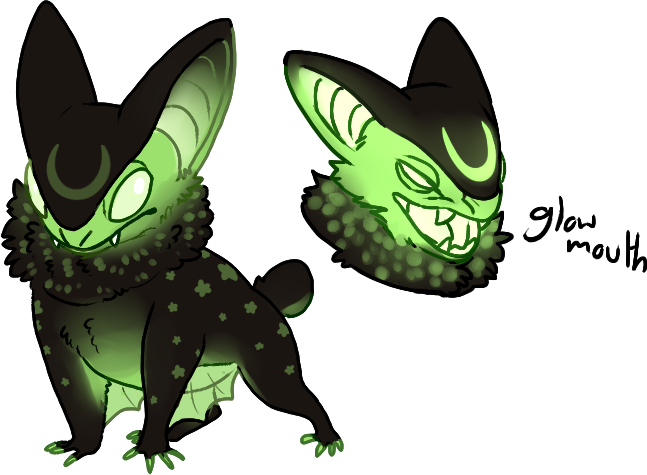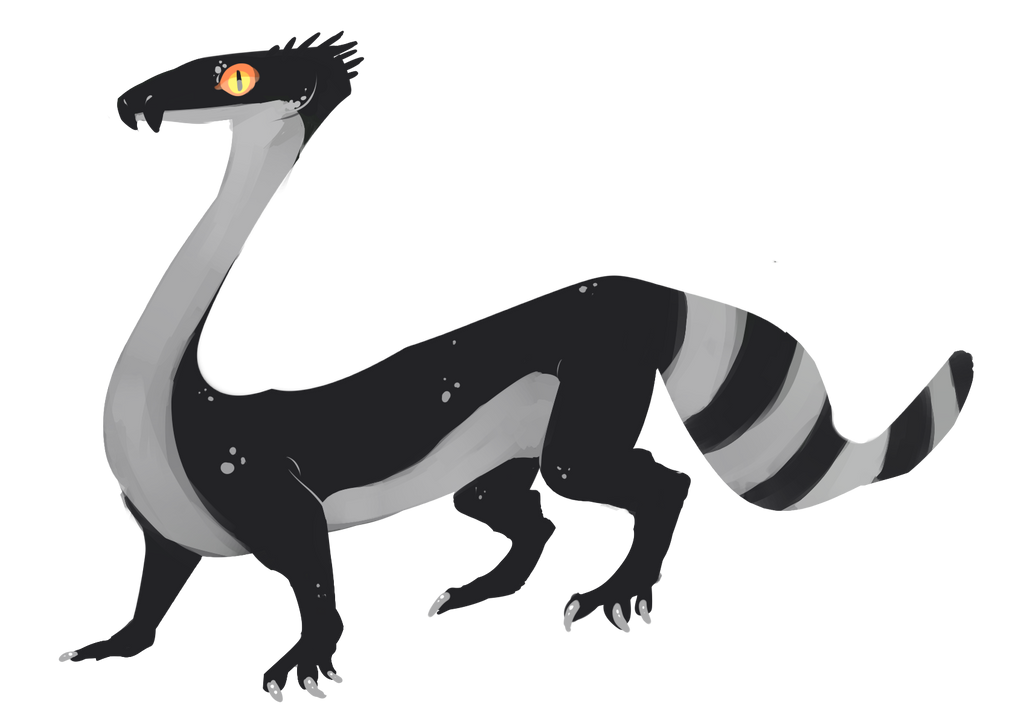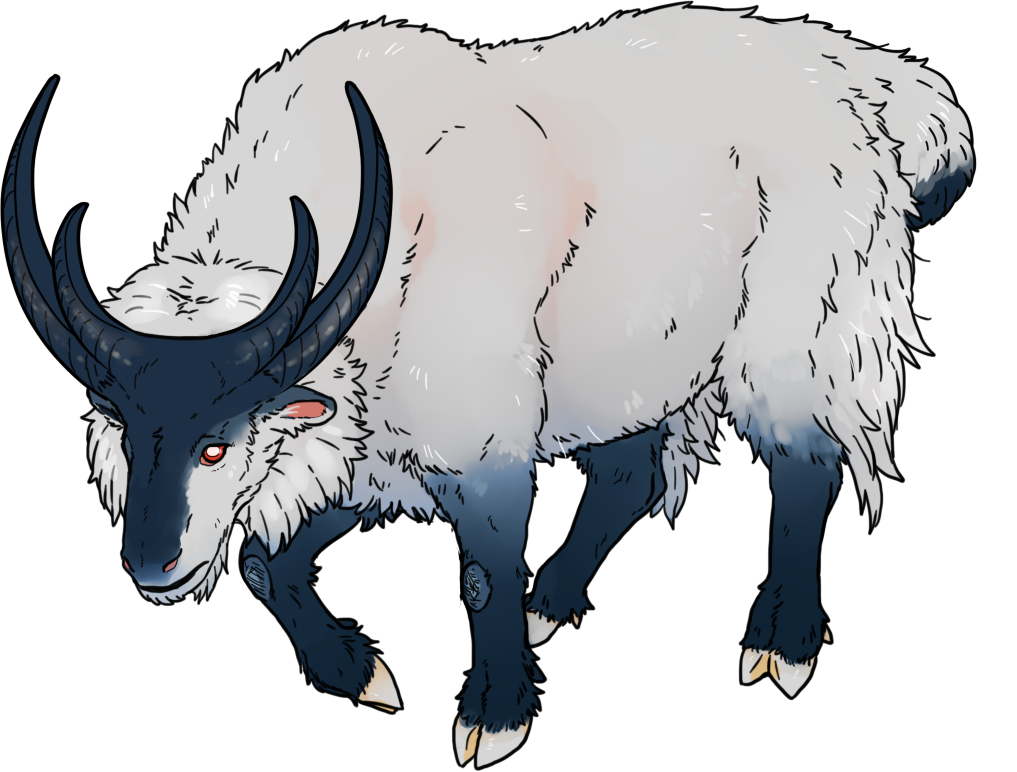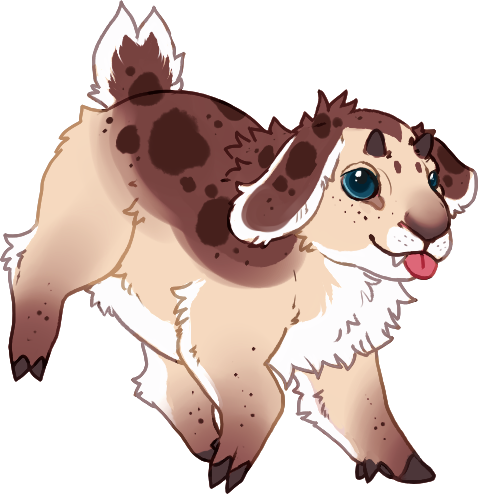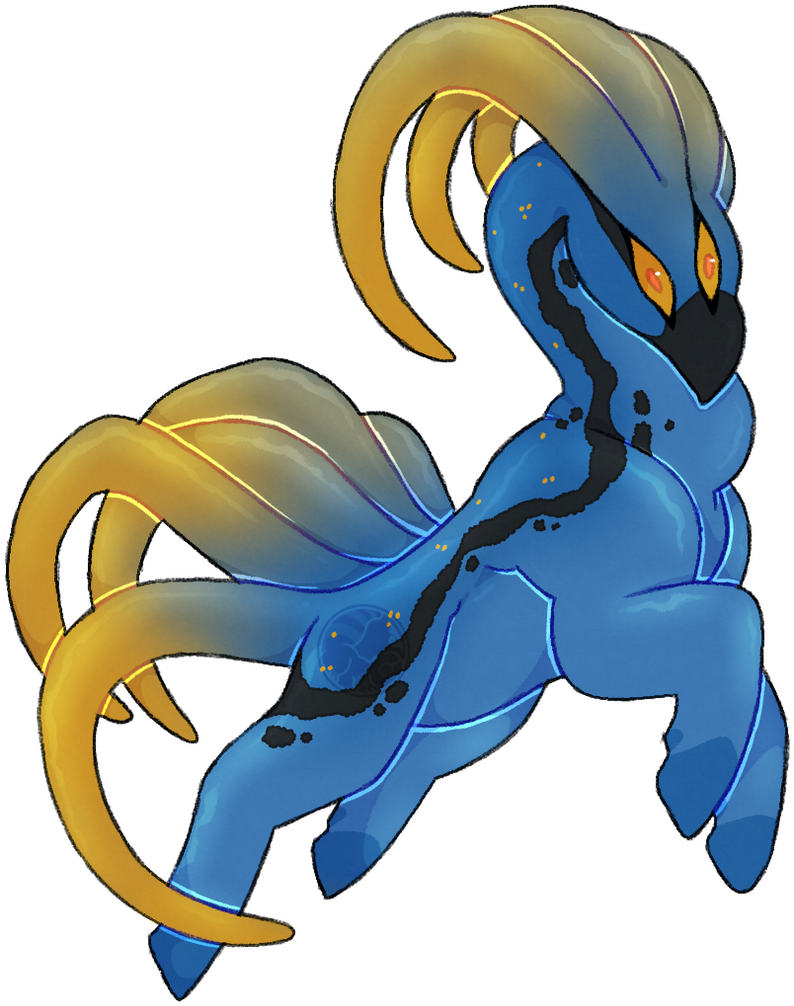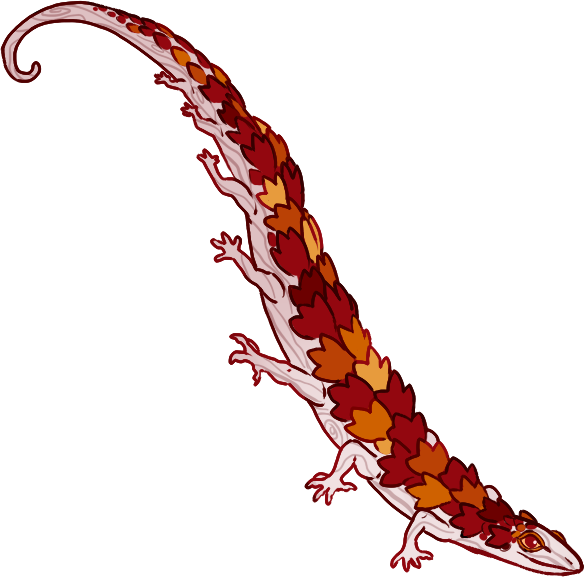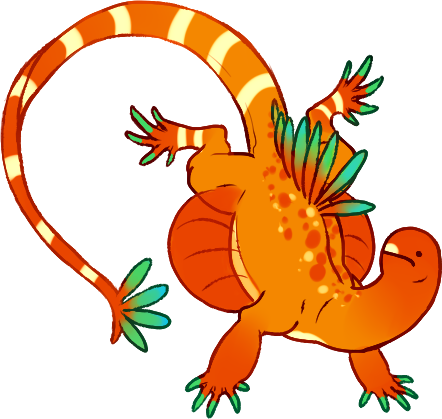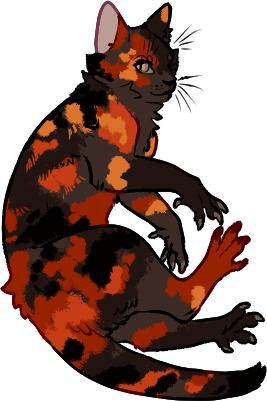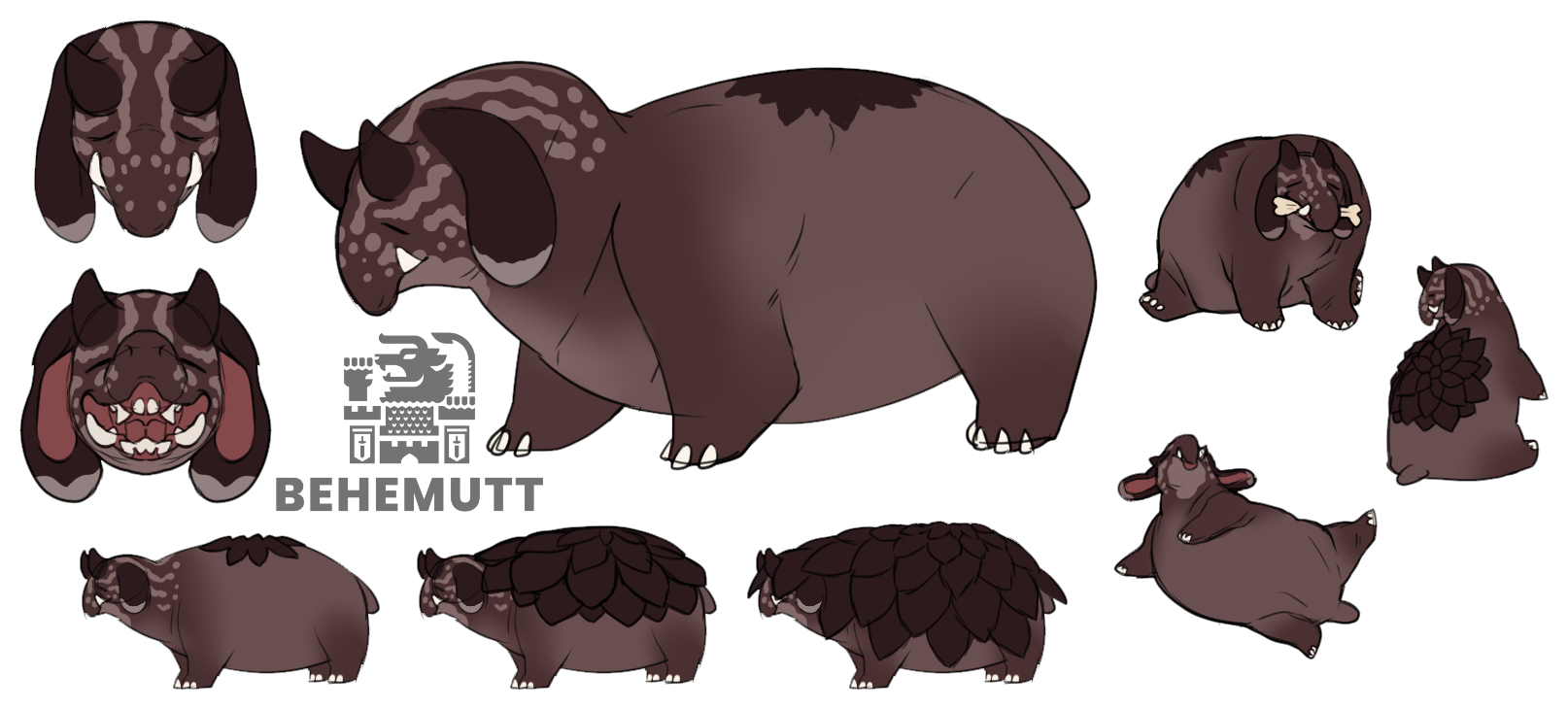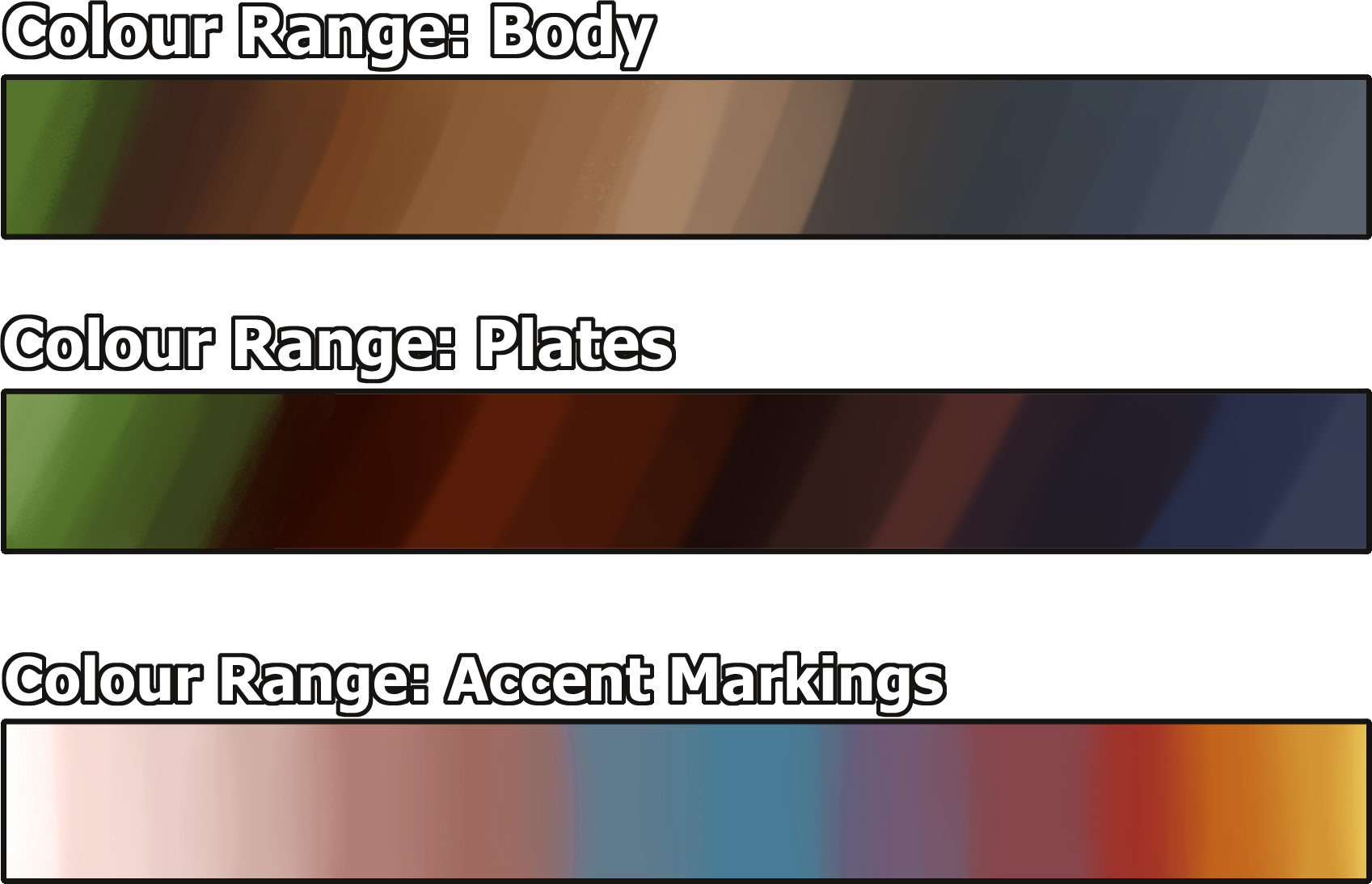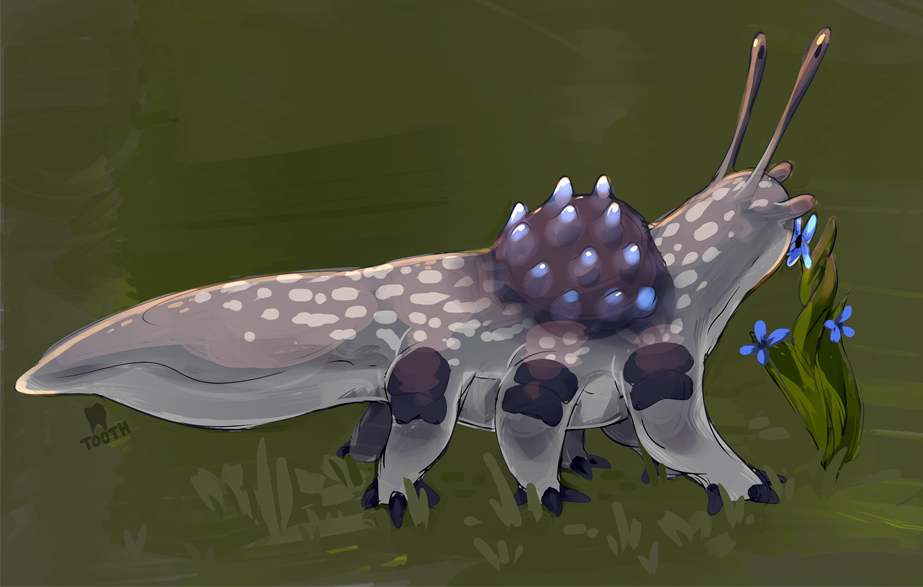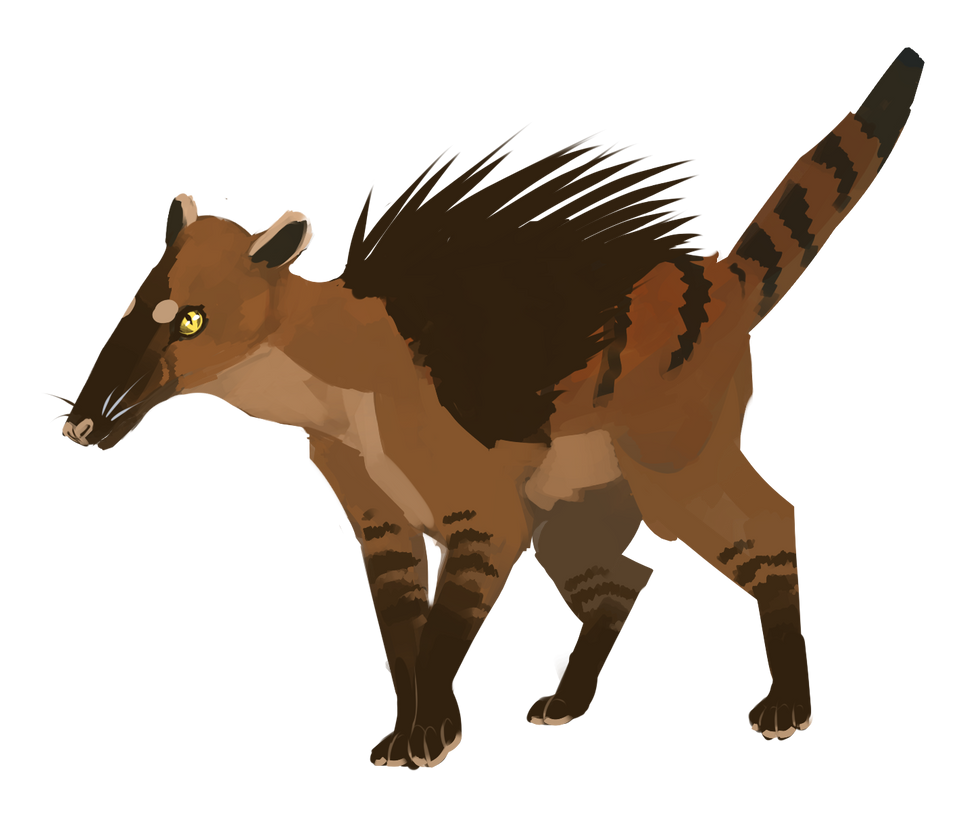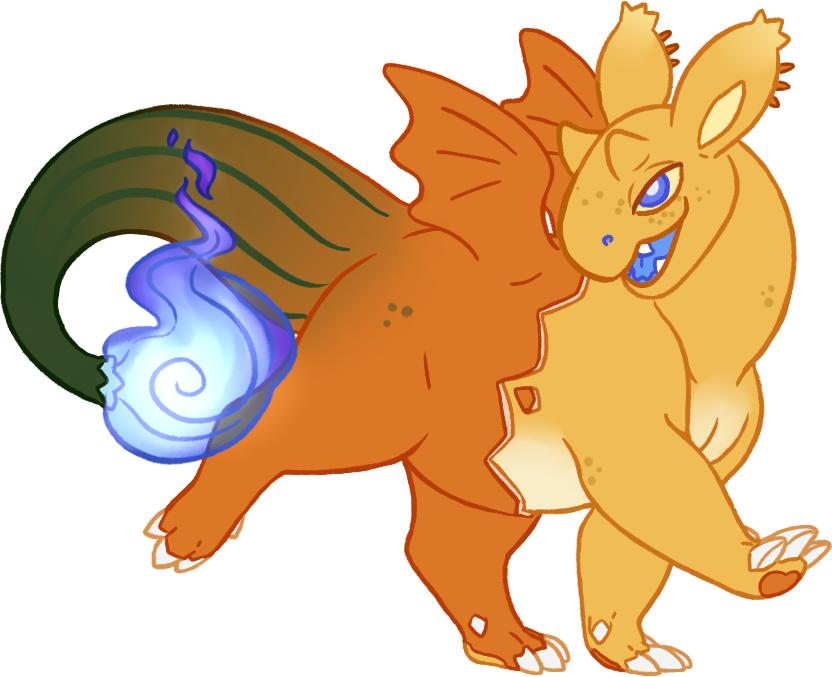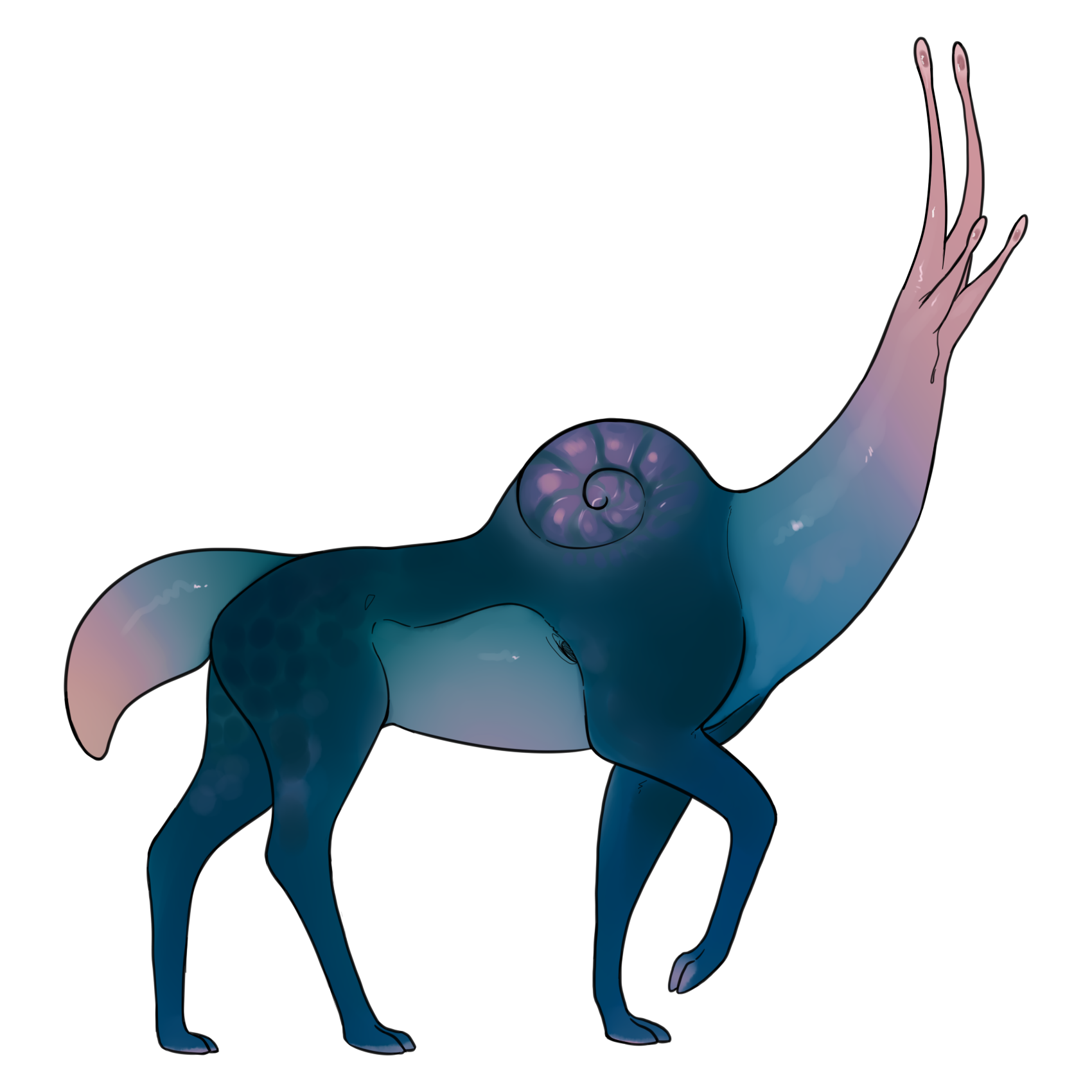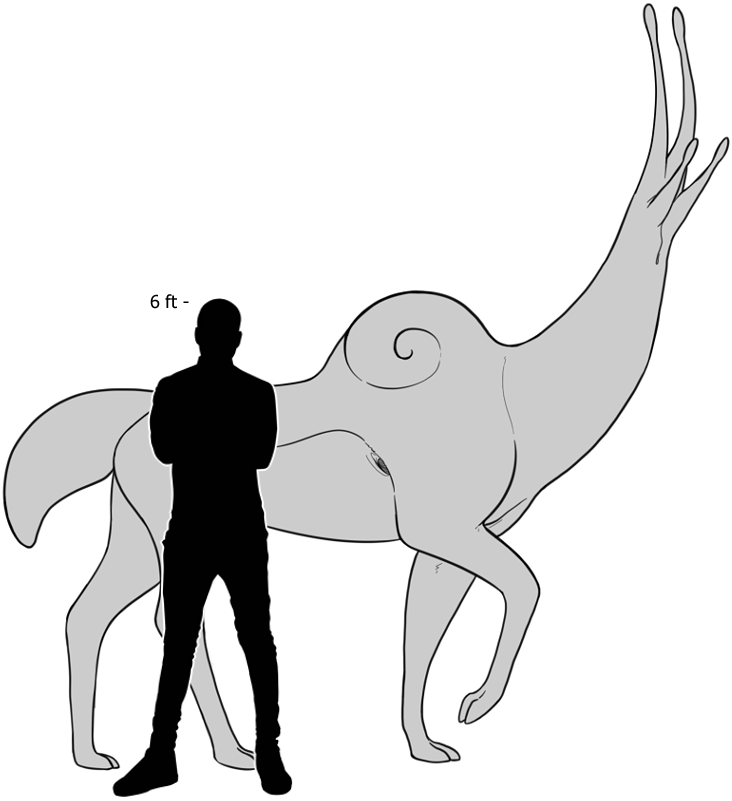Species
Grem
Visual Trait IndexBoggan
Status: Companion
Species Availability: Open , can make your own
Introduced / Native: Native
Size: 1 ft
Location: Rallome, Mezza, Austrum continents
Habitat: Cave Systems & Moss Forests
Base: (Base Link) You are only able to use this base if you own a ticket to create one!
-------------------------
Description:
This cave-dwelling species has had their anatomy evolutionarily altered due to their dependence on cave-like environments for food and shelter. This has caused them to lose their ability to fly, as well as growing larger heads, ears, and eyes for more optimal use of their sensory organs.
A Boggan’s claws are well adapted for clinging onto cave walls and climbing, giving them the ability to hold onto even the slipperiest of walls for their food. Their diet consists of plant matter & insects, particularly flightless cave moths, which make up a majority of their diet.
Boggans use bioluminescence as a form of communication with other organisms, flashing their luminescent markings in a rhythmic pattern to send signals to others. These signals are complex and can tell other boggans everything they need to know about an individual, where food is, whether there are threats in a certain area, and so on.
Misc Facts:
- Males tend to be the more brightly coloured of the sexes, but it isn't unusual to see females who will also sport this vibrant look.
- A female Boggan can bear up to 4 pups in a litter, she will typically barricade herself within a long hole structure called a "nest scratch" that her mate will dig for her. Females will use their bodies as a barricade to prevent predators from getting to her young, this however means she is totally dependant on her mate for sustainance for the first few weeks.
-------------------------
Basic Design Rules
Physical Requirements:
- Must have Large head, eyes & Ears
- Wing membrane must attach to both the arms and belly sides. Cannot be functional.
- Glowing markings are required, a marking must be present in order for it to glow.
- Glow is considered an accent and shouldn’t take up the majority of your Boggan.
Available Colours & Markings ✔️
-
All Colours are available to your Boggan.
-
Simple patterns are available but must be limited. (spots, stripes, gradients, rings, etc)
-
Geometric patterns are available but must be limited. (stars, hearts, any sort of cutey mark look)
Ferret Lizard
Species Created by Toothlessego
Status: Companion
Species Availability: Open, can make your own.
Introduced / Native: Native
Size: 3 ft
Location: Mezza Continent
Habitat: Forests, caves, shrublands
Base: (Base Link)
-------------------------
Description:
Ferret Lizards are slendered bodied animals built to slink through small areas and climb to gain access to birds and their nests. Their appetites are impressive given their size, making them a very active animal and eating twice their bodyweight in food to keep their metabolism in check. In the wild, these creatures live alone, taking down animals much larger than them with their miraculous stamina and amazing reflexes.
These animals are very popular in the pet business, with their playful personalities and interesting colour morphs. When tamed right, these guys make perfect lap pets!
Misc Facts:
- These omnivorous creatures will consume anything they can find in their unforgiven environment.
- Ferret lizards females will give birth to live young, having up to 6 pups in a litter.
- A very adaptable creature, can live in almost any climate.
-------------------------
Basic Design Rules
Physical Requirements:
- Long bodies with short legs.
- Minimum spines running along the back of their neck.
- 4 claws on frontfeet, 3 claws on back feet.
- 2 pointed notches on the mouth.
- slit pupils.
Available Colours & Markings ✔️
- All natural markings are available but must be minimal.(EG: spot, stripes, can be any colour, etc)
- All colours are available to your ferret lizard.
- eyes can be any colour.
-------------------------
Lubra (Ghoast)
Status: Mount
Species Availability: Open , you can make your own
Rarity: Common (1)
Introduced / Native: Native
Size:
Location: Rallome & Austrum
Habitat: Frigid Mountain sides
Base: Lubra
-------------------------
Description:
Lubra are a shy goat-like species that live primarily on high altitude mountain environments. on this terrain they use the treacherous and rocky mountain side as a form of advantage for their survival against hunting predators, this makes them a successful species as very few attempt to predate on them. Their bright thick wooly coats aid them in withstanding frigid temperatures , especially at night. Male Lubra will typically have denser longer fur around the neck and backside regions to show off their health and overall physique, as well as work to accentuate the size of their head and horns.
All sexes of Lubra grow 2 large Crescent shaped horns on their head. The larger set called the "Galla Horn" typically grow in first while the smaller "Fel Horn" will grow in later in life. Fel horns possess a unique ability to luminesce, this is achieved by Lubra gorging themselves on a certain type of plant that only sprouts during their breeding season. When this season comes around, Lubra will consume, resource guard, and battle for their right to gain the ability to partake in the luminscence dance, which requires a glowing Fel horn to participate.
Once night falls and the conditions are right, Lubra will then begin to bound around and fluctuate the glow in their Fel horn to show off their fitness and attract mates who are interested. These gorgeous displays are a great favourite among locals, and have become an attraction to eco-tourists. The Lubra dances go by many names, including the "lunar dance" and the "Fel Galla", all names attributing in someway to the double moons of Palleth.
Misc Facts:
- The large fur on the back legs of Males can be easily pulled off, this is used as a "get away" tactic if a predator is able to grab hold of the back of them. Because of this, Lubra fur is easily collectable, making them saught after fauna to collect from.
- It isn't unusual to see Lubra with unevenly shaped horns, there has been frequent documentation of Lubra with larger Moon horns and smaller main horns or vice versa on record.
- Lubra have a unique set of eyes which can dialate to let in more light, as well as a reflective film called a tapetum, giving them the ability to see better in the dark.
- Their diet consists of grasses, shrubs, salt and small insects.
-------------------------
Basic Design Rules
Physical Requirements:
- Wooly body with cloven hooves.
- Short ears.
- 2 sets of horns resting ontop of each other.
- Males require Mane around the neck.
- Small short tail.
Available Colours & Markings ✔️
- Only gradients and natural markings are allowed.
- Body should be light in colour while the legs & face are dark.
- Horns must be naturally coloured.
- ONLY the "Fel Horn" can glow. Able to glow any colour.
- Bioluminescence can be anywhere on the body but MUST be strictly an accent.
-------------------------
Goatpig
Species created by Kasmut
Status: Companion
Species Availability: Open , can make your own.
Introduced / Native: Native
Size: 1-3 ft
Location: Everywhere except cold continents
Habitat: Temperate climate habitats, Forests, Farmlands, etc.
Base: (Base Link)
-------------------------
Description:
A hybrid between both pig and goat, Goatpigs are very sweet and fun companions to have!
They love to go on walks and enjoy anything you feed them. Having a goatpig is like having a best friend for life!
Misc Facts:
-------------------------
Basic Design Rules
Physical Requirements:
- Rounded body
- cloven hooves
- 1 small set of horns
- goat ears and tail
- fangs
Available Colours & Markings ✔️
- Natural colours & markings are available. (EG: spot, stripes, can be any colour, etc)
-------------------------
Inkuine
Status: Mount
Species Availability: Closed species, you cannot make your own
Size Comparison: Pony to medium Horse size
Quick description: These omnivorous creatures are brightly coloured to ward off predators, indicating that they are poisonous and shouldn't be eaten. These creatures specialize in consuming certain plants that are considered poisonous to many others, they use this poison to convert into a weapon, lacing it within their skin.
Base:
If you have a token to create an inkuine and you would like to use the pre-made base when designing your pet, you can find the Inkuine base Here.
For more information on how to design and color your inkuine, please check out the species guide Here.
Facts
-Can shoot slime as another form of defense from its mouth.
-Able to crush seashells with its beak to get into the juicy morsel within.
-The poison is only active when ingested and can cause a burning and stinging sensation all within your body, so please wash yourself after riding one of them.
(More info about colouration will come in the future)
Ivy Lizard
Status: Companion
Species Availability: Open, Can make your own
Introduced / Native: Native
Size: 10 In - 3 ft
Location: Everywhere Except North & South Poles
Habitat: Forested Areas & Rocky Regions
Base: (Base Link) You are only able to use this base if you own a ticket to create one!
-------------------------
Description:
This arboreal Species is built for the trees and canopy, barely coming down unless pushed out of their territory by competitors or predators. They can live both on insects and nectar or sap. Ivy Lizards have a particular interest in collecting seeds on their backs, tending to them until they grow over their entire body as a form of camouflage. Ivy is a favourite of the species, hence the name.
Ivy lizards are live bearing reptiles, carrying their young on their backs once born. When an ivy lizard is young, their first seeds will typically come from their parents as they hide in their foliage. There is significance in trimming down the foliage of an ivy lizard, this practice prevents the overgrowing roots and leaves from impeding their legs.
These creatures come in a huge variety of colours, changing their skin overtime to match the foliage they choose to carry on their backs. The plant life can vary from lizard to lizard, some even having multiple species of plants on their backs.
Misc Facts:
- The offspring of an ivy lizard will live on the backs of the male parent for a few weeks, collecting the seeds for their own use in order to start them off early in life.
- Ivy lizards typically have 4-5 sets of legs, but there have been any documented to have exceed that number.
-------------------------
Basic Design Rules
Physical Requirements:
-
Must have at least 4 sets of legs. Able to have as many legs as it’s size can handle.
-
Must have one host plant growing along it’s back.
-
Plants should be proportionate to the lizard’s size and manageable for their body.
Available Colours & Markings ✔️
-
All Colours are available to your Ivy Lizard.
- Simple natural patterns are available. (spots, stripes,gradients, rings, etc)
Krag Crab
Status: Companion
Species Availability: Open Species, can make your own
Size Comparison: ~1 foot tall
Quick description: These large crustaceans travel long distances over the course of their lives, nonspecifically scavenging for food. They prefer activity in the dark, accumulating in big groups at night. Sometimes they can be seen sweeping through foggy graveyards, picking moss and lichen off of headstones. There are stories that they guide souls to their resting place using the glassy, light-reflecting stones embedded in their shells. If kept as pets, they may have a tendency of picking up bright objects and 'decorating' their living space (or shells!) with them.
Lyzzand
Status: Companion
Species Availability: Open Species, can make your own
Size Comparison: Small Iguana
Quick description: Lyzzands are a lizard species imported from the planet Daeis, they use the extra skin on the sides of their bellies to pocket air and glide over water. In Daeis, their colours would serve as camouflage in their bright coloured environment, but they stand out significantly on Palleth.
Old World Cat
Status: Companion
Species Availability: Open, can make your own.
Introduced / Native: Native
Size: 9-20in (Length)
Location: Found Everywhere
Habitat: Forests, Farmlands, Deserts, Cold climate areas, etc.
Base: (Base Link)
-------------------------
Description:
A domesticated cousin of the wild Grypha Cat, Old-world cats have lived as a true companion to many cultures for thousands of years. These feline friends are very similar to earthly cats, save for their feet which have a strong resemblance to a bird’s claws or talons. Older lineage of these cats can also have pseudo-wings and feathery protrusions on their shoulders and rump.
-------------------------
Basic Design Rules
Physical Requirements:
- Typical "Domestic Cat" body type
- Bird feet on atleast 1 set of feet
Available Colours & Markings ✔️
- Naturel colours & markings are available. (EG: spot, stripes, can be any colour, etc)
-------------------------
Patago
Status: Mount
Species Availability: Closed, cannot make your own
Introduced / Native: Native
Size: 7-10ft
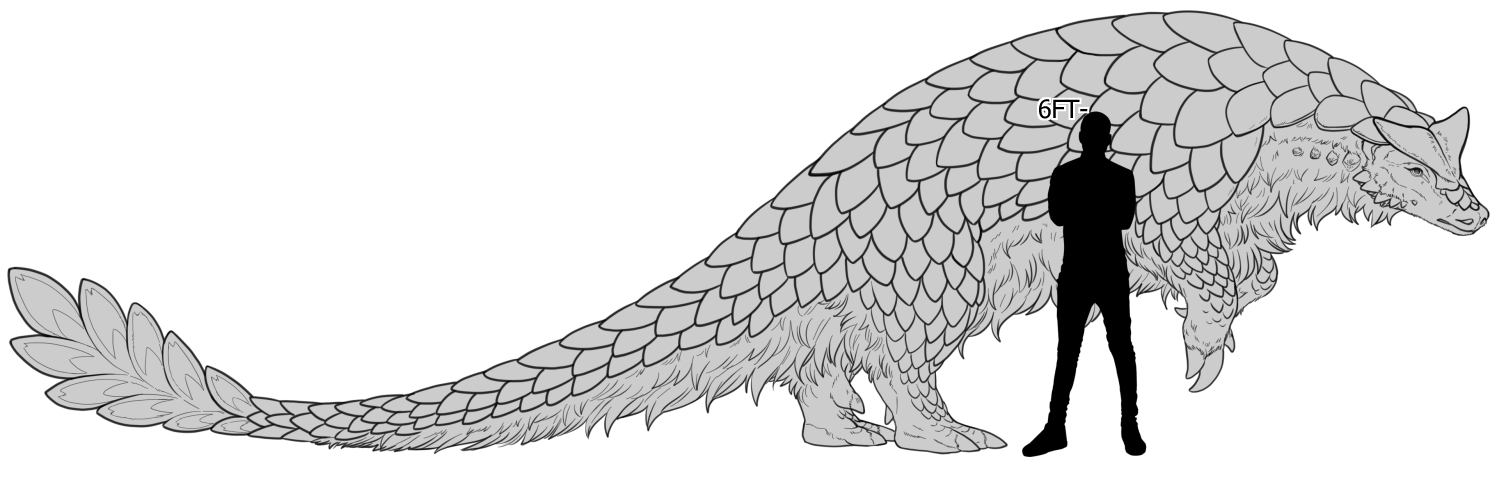
Location: Vercia Continent
Sporadically found in the Dyul & Yurich region
Habitat: Arid desert region & Oasis habitat
Base: Gold Faced Patago You are only able to use this base if you own a ticket to create one!
-------------------------
Description:
Hefty massive creatures found primarily within the desert range of Vercia. Patago have a varied appetite and will consume whatever is available to them so it isn’t unusual to see them consuming meat when necessary. Primarily their main diet consists of large insects and larvae, roots, and tubers.
The practice of owning and raising a Patago is specific to the culture of Vercian natives (named Duroga) and is often seen as a right of passage for the younger generations of their people. Durogans are one of the only cultures on Palleth to care for and even ride these large creatures. Because of their strong cultural significance, for an outsider to be allowed to take-in and care for one of their own is seen by the Durogan people as a sign of great reverence and trust for that individual.
Durogan’s use these large beasts as their primary form of transportation and as cargo haulers, but also as a form of livestock wherein they are able to utilize the milk, meat, and hide of said creatures. In owning one you agree to take on the sacred duty of caring for them, as this species is highly revered by their people and every Patago is protected and treated with the utmost care, including those that would be ultimately harvested for their meat. Disrespecting or mistreating a Patago will result in severe consequences for that individual.
Misc Facts:
- Males & Females both grow horns on their head, using them to bash and wrestle for dominance.
- Their Fan-like Tail is made of harden modified scales, some are sturdy and sharp to slice at opponents, while others are light and rattle to scare off predators.
- Their diet consists of large insects, primarily eating a specific species of large termite endemic to Vercia.
- Patago get all of their water from their insect diet and typically do not drink.
-------------------------
Basic Design Rules
Physical Requirements:
- Plated Back Scales
- Eyebrow Horn Crests
- Large Digging Claws
- Large Tail Ornament
- Light Coloured Belly
Available Colours & Markings ✔️
- Melanism
- Leucism
- Natural Markings such as stripes, spots, gradients, rosettes, points, etc.
Colour Range
Black, White and Warm Colours are permitted.
Plentiful Stoutan
Status: Companion
Species Availability: Closed, you cannot make your own
Introduced / Native: Native
Location: Resides on the Island of Karmos & other small parts of the southern Mezza Continent
Habitat: Heavy Jungle & Bamboo Forest
Size: 10” - 20”
Base: Plentiful Stoutan Base
You are only able to use this base if you own a ticket to create one!
-------------------------
Quick Description:
This portly animal is known for having poor eyesight but an excellent sense of smell which it depends on as it shuffles through its heavily forested environment. Stoutans are specifically known for their “armour-like” plating which grow in the form of hardened keratin over their lifetime, An adult Stoutan is completely armoured in these scales which makes them resemble the look of a pangolin or snake fruit. Their thick hide, fatty meat, tusks, horns & scales are highly sought after for hunters which has incidentally caused their populations to drop in many areas.
Stoutans require a high calcium diet in order to grow their scales, this is typically the reason for their large congregations around calcium deposits, decomposing bodies or bone piles.
Being a rather quiet and timid species, males prefer to avoid conflict, only to display themselves using their tusks and brightly coloured face markings.
Misc Facts:
- VERY HEAVY!
- Owners of this animal require supplying their Stoutan with many bones.
- Lack of calcium can cause deficiencies & prevent scale growth, making them very naked and very vulnerable.
- Has a scent gland that secretes foul odor if threatened.
-------------------------
Basic Design Rules
Plentiful Stoutans Require:
- 2 tusks
- 2 horns
- Flopping ears
- Short nails
- Back scales
- Rotund body shape
Unavailable Colours/Markings/Traits❌
- Albinism / Piebald
- Unnatural markings
- Bright colours (must be muddy and natural coloured)
Available Markings ✔️
- Melanism
- Natural Markings such as stripes, spots, gradients, rosettes, points, etc.
COLOUR RANGE
Stoutans come from very green and earthy environments, it’s significant for them to be able to camouflage in such environments to avoid predators.
The colours depicted here are loose iterations that are requested to be worked within, some deviation is allowed but if the design is too far from the natural look of the creature then it has a high possibility of being denied.
Free choice of colours on: Eyes, Mouth, Claws, Teeth
Podlet
Species Created by Toothlessego
Status: Companion
Species Availability: Closed, cannot make your own.
Introduced / Native: Native
Size: 1 ft
Location: Rallome Continent
Habitat: Grasslands & flowerfields
Base: (Podlet Snorse) You are only able to use this base if you own a ticket to create one!
-------------------------
Description:
These wild little critters are much smaller relatives of the common riding Snorse! Semi-arboreal as juveniles, they use their three pairs of legs to help them climb, until they're heavy enough that it becomes ungainly. Unlike their more leathery counterparts, the common Snorse, these guys are much slower, softer and squishier, with frog-like skin. The Violet Dart flower is a major part of their early diet, giving them a toxic/foul tasting resistance against predators. A couple of other defenses include the ability to spray sticky slime from their lower antennae, And bright warning colors displayed on their shells!
A podlet snorse is a meandering little animal, focused almost entirely on getting to their next meal as they plod along. Quick movements may startle them into a defensive response, but any grems or humans that wish to feed one need only be still and patient!
While their diet is mostly herbivorous, preferring the petals and stalks of blue flowers, they’ll make an exception to slurp up insects or worms that cross their path! They’re especially fond of the violet dart flower, a plant which helps to boost their toxin producing capabilities in their early life.
Podlet snorses are mainly solitary once they reach maturity, but as juveniles they may be seen in larger groups, or ‘stocks’ as they travel through forests or fields for sustenance.
They will greet or identify other podlet snorses by pressing all four of their feelers together.
-------------------------
Basic Design Rules
Physical Requirements:
Podlet Snorses may have shells that vary, some grown outside of their skin (like a snail) while others of this species can have them emerging from under their skin (like a semislug).
- Slug body with 6 legs altogether
- 3 hoof toes per foot
- Shell on the back
- Armoured shoulders
Available Colours & Markings ✔️
- Podlet Snorses come in a wide variety of colours.
- Podlet Snorses are required to have vibrant blues somewhere on their shell. Any shade of blue is fine as long as it is the most vibrant part of the shell.
-------------------------
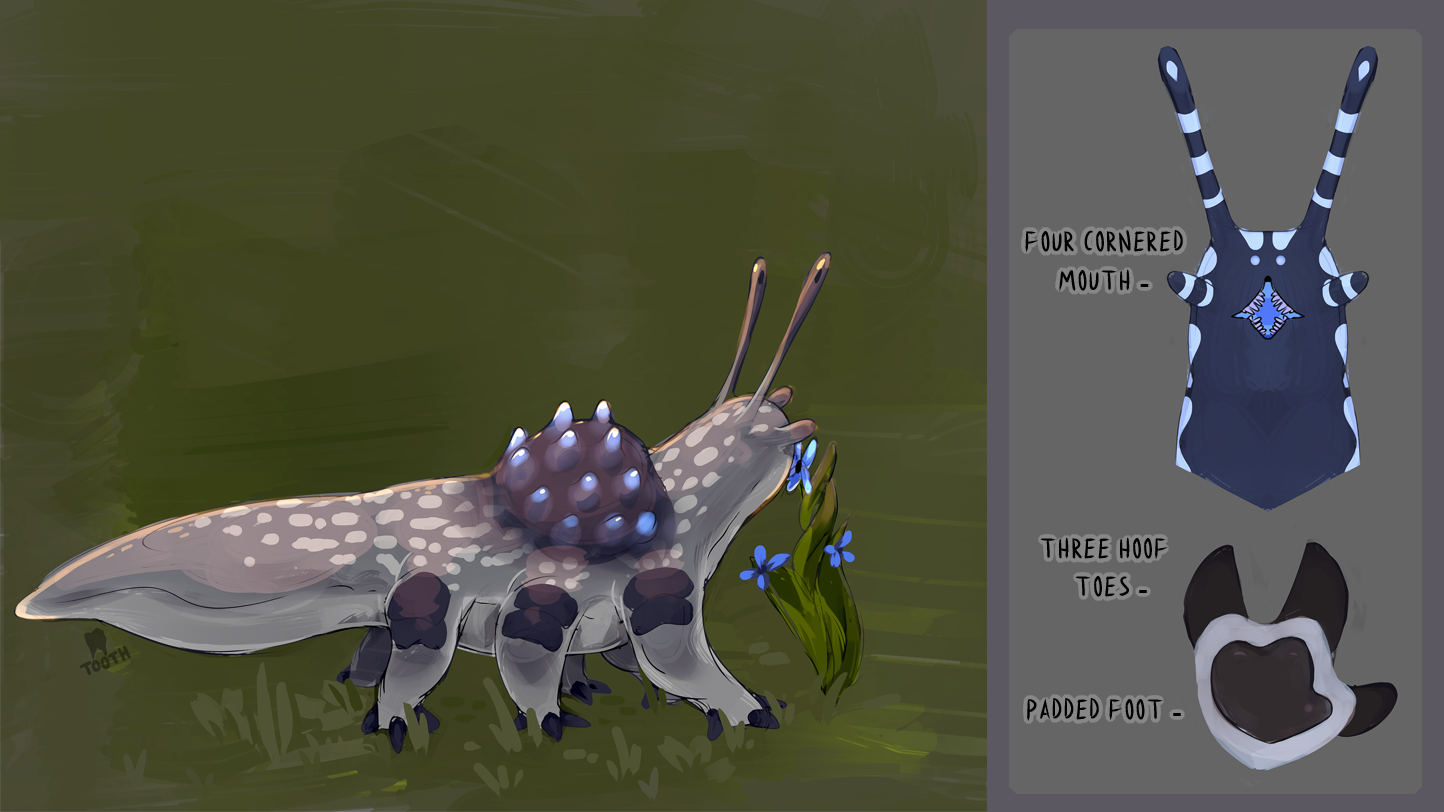
Porcudevil
Status: Companion
Species Availability: Open Species, can make your own
Size Comparison: Medium sized dog
Quick description: Porcudevils live up to their name, not only by their resemblance to earth animals, but by their temperament! They're feisty troublemakers, likely to choose favorites and misbehave around anyone else, but they're very loyal to those they respect. Very tough and smart animals with nasty spines and protective of those they respect, porcudevils make excellent guards!
Pumpkimp
Status: Companion
Species Availability: Closed Species, Do not make your own please!
Introduced / Native: Native
Size: 1-2ft
Weight: 15lbs to 30 lbs
Location: Everywhere except cold continents & Desert Continents
Habitat: Temperate climate habitats, Thick forests, Farmlands, Swamps
Base: Pumpkimp You are only able to use this base if you own a ticket to create one!
This companion is an event exclusive and can only be created from its corresponding token item. [Token: Pumpkimp]
-------------------------
Description:
A small dragon-like species with an impish disposition. They once lived primarily in a small area in the Parchin Region, but as the species became more well known, its popularity had caused the species to become widespread across the world of Palleth, making them a pretty iconic little animal among the masses.
This species is equal parts devious & shy, making them very easy behind-the-scenes troublemakers. Befriending a pumpkimp is no easy feat as most adults are distrustful of outsiders, making them very closely knit familial creatures, each with their own individual set of prerequisites that must be met in order to form a close bond before they will consider someone part of their group.
The diet of a pumpkimp consists of an omnivorous variety of Roots, Cucurbits, Flowers, Insects, Nuts, Seeds, and Small animals like Squirrels, Amphibians, Bats and Lizards.
Pumpkimp patches can vary from 10 to 15 adult members, living together in burrows or nests within thickly forested areas (preferably from soft fertile forests and wetland prairie mixes). These close knit groups are very pack oriented, caring for offspring as a family. These patches can vary, however this all depends on the group type where some are composed of only related pumpkimps while others are camaraderie groups of no relation to each other. Unrelated patches tend to be made up of individuals who have left bigger patches to find mates or friends to keep them company.
Though recently the habit of staying in large groups has shifted to aim for more nomadic lives due to their curiosity and need for travel and new experiences. With the species' population becoming so widespread, the new behaviour of seeing them either by themselves or in groups of two have become a more common sight as they travel their new territories and find new places for themselves.
The way this species reproduces has greatly contributed to their sudden/large increase in range and change in lifestyle. This species regularly uses jack-o-lantern pumpkins as the carrier for their young, turning them into one large “egg” through the use of mysterious magical abilities between the two pumpkimps. Any pumpkimp at the adult age of 5 years have this capability. Because these types of pumpkins are a widely sought after commodity to other sentient species, they have flourished across continents in places where they never could have without the help of humans spreading their crops throughout every corner of Palleth.
Pumpkimps have a lifespan of 15 years in the wild, though some have gone on to live up to 40 years if cared for properly. The age of adulthood for a pumpkimp is around 5 years, this age can be identified by their fully developed horns and teeth.
Misc Facts:
- Pumpkimps harbour some pretty formidable chompers! Their dentition is equipped for crushing hard gourds, roots, and even bones with their immense jaw pressure, using the back teeth to grind it down for proper consumption. Sometimes called “the Trashcans of the Forest '', these pumpkimps can digest just about any hard plant and animal matter due to their high internal body heat and highly corrosive stomach acid.
- Able to levitate small items and possess plants.
- Can breath fire through mouth and expel fire through its tail.
- These creatures have the ability to “spitfire” flames from their mouth with the use of a chemical reaction that happens within special organs placed in their throat. This spitting action can only be seen when they are under threat, most would rather reserve their spitfiring as it can be very resource heavy.
- Can be found in thick forest, pumpkin patches, cemetaries, large fields, old abandoned buildings.
-------------------------
Basic Design Rules
All visual requirements can be found here
Pygmy Moonbawk
Status: Companion
Species Availability: Open , can make your own.
Introduced / Native: Native
Size: 15 in
Location: Everywhere except cold continents & Desert Continents
Habitat: Temperate climate habitats, Forests, Farmlands, etc.
Base: (Base Link)
-------------------------
Description:
This Domesticated Chicken is an old breed of hen originally created in the Region of Aviana.
This breed may not be the smartest or the hardiest, but are formidable egg layers with a bold personality. Moonbawk have longer laying periods than a lot of other breeds and lay light blue eggs, making them a sought after breed for chicken enthusiasts.
Moonbawk are very well known, not only for their egg laying, but for their cat-like paws as well, which even have retractable claws that a Moonbawk can use to climb up surfaces if they're tenacious enough.
Being flightless and rather small however can come with its own complications, making them easy prey for a number of wild animals. They are also prone to getting sick easily if the weather is too cold or too hot, or if their scruffy, absorbent feathers stay wet for too long. You’ll need to ensure that your coop is predator-proof and that your Moonbawk is safe from harsh weather if you decide to own your own flock.
-------------------------
Basic Design Rules
Physical Requirements:
- "Silkie Chicken" body plan
- Feet must be paws similar to a feline's
- fuzzy body type
Available Colours & Markings ✔️
- limited to solid colours, speckles, spots, and/or gradients
Colour Range
These are typically the main colours of a moonbawk’s fur, feel free to deviate a little from this, but avoid creating unnaturally coloured Moonbawks.
-------------------------
Qumot
Species created by Sarspax
Status: Companion
Species Availability: Closed, Cannot make your own.
Introduced / Native: Native
Size: 7ft (length)
Location: Austrum Continent
Habitat: Rocky outcrops, Mountainous regions, Shrublands & Caves
Base: Qumot
You are only able to use this base if you own a ticket to create one!
-------------------------
Description:
This pack hunting predator navigates its territory with the heat sensing barbels on it's head. Despite its lack of eyes it has no trouble 'seeing'. Though not as useful in this new environment, the bright armored nodules along its body muddy its own heat signature, confusing other predators and prey from its native home. The bright blue tendrils along the top of its hips and the end of its tail produce a painful but non-lethal sting. They use teamwork and their exceptional climbing skills to corner and ambush larger prey.
Misc Facts:
-
Stinging tendrils will regrow if damaged; the sting is painful enough to temporarily incapacitate something as large as a moose.
-
Can climb most rough vertical surfaces like cliffs and trees but nothing smooth like concrete, metal, or glass.
-
Capable of eating anything it can rip apart with its strong jaws but prefers live, warm-blooded prey.
-------------------------
Basic Design Rules
Physical Requirements:
- Long body with nodules all over neck and tail
- barbels on face, rumps & tail
- 4 fingers per foot
Available Colours & Markings ✔️
- For more information on how to design and color your qumot, please check out the species guide Here.
-------------------------
Ruffled Snapper Lizard
Species Created by Toothlessego
Status: Companion
Species Availability: Open, can make your own.
Introduced / Native: Native
Size: 3 ft
Location: Northern Regions of Rallome Continent
Habitat: Snow-Covered Forests
Base: (Base Link) You are only able to use this base if you own a ticket to create one!
-------------------------
Description:
A subspecies to the Ferret lizard, these creatures are well adapted to frigid temperatures, and are commonly found in frozen tundra or taiga environments. Their thick fur helps them stay insulated, with fluffy feet to aid them in maintaining their mobility up as they glide across the snow. These agile predators have a high metabolism and are akin to stoats in their agility and high stamina, sporting a gnarly set of clear teeth to bite with ferociously quick snaps in order to bleed their prey and track it down.
When in a defensive stance, the spines on their tail can be used similarly to a porcupine, giving them the ability to embed their spines into an assailant with one quick tail smack. Snapper lizards tend to rattle these spines on the ends of their tails to ward off competition or big predators looking for a quick meal.
Misc Facts:
- These omnivorous creatures will consume anything they can find in their unforgiven environment.
- Buffshrooms are a staple part of their diet. When the season for these mushrooms come around, these lizards will work hard to collect and cache as many as possible in order to hold them over through the harsh winter seasons.
- Ruffled Snappers are very sensitive to temperatures, living anything hot can cause them to overheat.
-------------------------
Basic Design Rules
Physical Requirements:
- Long bodies with short legs.
- Minimum fur on the tail and neck, maximum fur all over the body.
- 4 claws on frontfeet, 3 claws + 1 dewclaw on back feet.
- Body quills .
- slit pupils.
Available Colours & Markings ✔️
- All natural markings are available but must be minimal.(EG: spot, stripes, can be any colour, etc)
- body limited to muted light shades with very minimal colouring..
- eyes can be any colour.
-------------------------
Shiffri (Stone Spirit)
Status: Companion
Species Availability: Closed, cannot make your own
Introduced / Native: Native
Size: 2-3ft
Location: Found everywhere.
Habitat: Typically found in forested areas, but it isn’t uncommon to find them in grasslands, rocky regions, villages, cities, and more.
Base: (Base Link) You are only able to use this base if you own a ticket to create one!
-------------------------
Description:
Also called stone spirits, or stone goats, the Shiffri are a wandering ethereal species created by the run-off of residual spiritual energy.
Their bodies are made entirely of stone and adorn a hard wooden mask. Each Shiffri’s mask is carved in the face of a human mixed with some form of animal, and can have a variety of different facial hair types sprouting from their masks.
This creature’s common characteristics are resting in one place for days, though some will rest for months, years, or even longer. They’re incredibly heavy in this state, making them near impossible to move. It’s said that forcing a Shiffri to move will give you endless bad luck, or worse.. Could cut years off of your life.
Shiffri are also known for walking silently and only at night. They are very sensitive animals and will become anxious if stared at. This will cause them to become stationary once again. You will find Shiffri commonly around bustling areas, or places with heavy amounts of spiritual energy, as it’s fabled that this species feeds off of said energy.
Though a nuisance to some, Shiffri are also highly revered in many other cultures, these cultures commonly adorn their stone bodies with offerings of silks and high quality outfits in exchange for them to provide their village with spiritual protection.
-------------------------
Basic Design Rules
Physical Requirements:
- Must have a body made of stone
- A single wood mask is required (carved animalistic and/or human)
- Must have one set of horns and four feet (feet can be any foot type)
Available Colours & Markings ✔️
-
Stone body are required to be a series of Dark colour (Eg: blacks, browns, and/or greens, darl blues etc), bright saturated colours are not accepted.
-
Wood mask can be based off of any kind of wood and can be any colour.
-
Can be adorned with outfits, trinkets, accessories, and/or can be covered in plants which can be brightly coloured.
Snorse
======
Species created by ToothlessEgo
Status: Mount
Species Availability: Closed, cannot make your own
Introduced / Native: Native
Size: 5-6 Ft (At the Shoulder)
Location: Larmonis Region
Habitat: Wide Wetland/Grassland Mixture and Tide pools
Base: Snorse You are only able to use this base if you own a ticket to create one!
-------------------------
Description:
The Snorse is a large land creature that commonly grazes on the rich grasses of the Larmonis Region. They are visually akin to massive legged snails, sharing similar features like having a protective shell, 4 eyes, scraping mouth part and tacky skin. The skin of an adult Snorse is tough and difficult to tear, making them a daunting animal to hunt for even the most experienced predator. The shell of a snorse grows with them and can be shaped by the environment in which they live, and the diet that they consume, making each one unique in nature. This creature forms close bonds with their fellow snorses and will form herds to garner the safety benefits a group brings.
The lifecycle of a Snorse is one of the most heavily documented forms of research in animal science. As large groups of Snorse will come together in mega-herds to make their way towards the shores and tidepools spanning all along the border of Larmonis. These shoreline areas are a key breeding ground for the Snorse, turning into nurseries for their offspring, so that they may grow large enough to become independent from their parents.
Reaching up to 60 Km per hour, these surprisingly swift animals can clear vast swaths of land in a short amount of time, making them a sought after mount for enthusiasts of this species.
Misc Facts:
- Snorses, like snails, possess both reproductive organs. These creatures will similarily "joust" in order to spear the other snorse in order to determine who will carry the offspring.
- The healthier and more extragavently coloured a snorse's shell is, the healthier they are.
- Their diet consists of primarily vegitation and rotting material.
- The ears of a snorse can be seen behind their elbows.
-------------------------
Basic Design Rules
Physical Requirements:
- Must have a snail face.
- Must have a basic rounded snail shell. (No Points or edges, cannot replicate oceanic shells, Eg the “conch shell” look)
- Must have cloven hooves.
Available Colours & Markings ✔️
- All Colours and Markings are available for this species.



